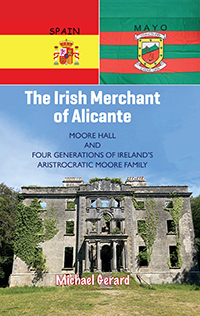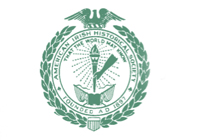by Michael Gerard
In contrast to my 2021 historical novel ‘Ireland’s Final Rebellion and An American Dream’ which focused on the frontline fighting of The Tan War and the founding of the Irish Free State, my new book ‘The Irish Merchant of Alicante’ looks at the struggle for Irish freedom from the perspective of the landed gentry. I have done this through the real-life experiences of the Catholic aristocratic Moore family, who built the magnificent Moore Hall on the shores of Lough Carra in County Mayo, between Claremorris and Castlebar.
After the defeat of the Old Gaelic Chieftains and the murderous rampage of Oliver Cromwell, millions of acres of Irish land were confiscated by Britain. Parliament decided to “plant” Protestant settlers from England, Wales and Scotland on these formally Catholic owned lands – their master plan being to subjugate the Irish ‘tenants’ and turn them into loyal Protestants. The Moore’s from Yorkshire were one of the planted families, who became part of this new landlord class – they built a house / estate in Straide, County Mayo which they named Ashbrook. They followed the designated model and installed Irish Catholic peasants as tenants on small holdings for which they had to pay high rents. Over time many of these settlers gradually adopted Irish ways, customs and even religion. By the dawn of the eighteenth-century John Moore, Master of Ashbrook at that time had married Jane Lynch from one of the Tribes of Galway families and had converted to Catholicism.
In ‘The Irish Merchant of Alicante’, I begin the story during the harsh Penal Laws that were introduced in 1695 to punish Catholics, especially the Catholic gentry, to force them back into the Protestant fold. Young George Moore faced these obstacles and as second son he could not inherit the Ashbrook estate, nor was he allowed to become a barrister or an officer in the British Army. He emigrated to Catholic Spain to join his mother’s relatives, descendants of the Wild Geese who were established merchants there. George found great success in Spain and by the time the Penal Laws were relaxed he was a wealthy merchant with his own fleet of ships. His longing for his homeland never waned and he returned, purchased some 12,000 acres in his native Mayo and built Moore Hall in the 1790’s, to become the First George Moore of Moore Hall. He had to swear allegiance to the King and had to follow the established landlord-tenant model; he did this in a fair and humane way, and he strove to establish more personal bonds with his tenants, including mastery of the Gaelic spoken by them.
In Ireland, George’s Spanish-born eldest son, John, was quickly smitten by Wolfe Tone’s ideals and he joined the ranks of the United Irishmen. He left his law studies and rushed to join with General Humbert’s French expeditionary army that landed in County Mayo, in support of the 1798 Rebellion. John was appointed the first President of an Irish Republic – Connaught. He made the ultimate sacrifice for this ‘treason’, and the associated trauma caused the untimely death of his father George in late 1799. The second son, George, then took the reins at Moore Hall. He was an academic, a reclusive historian who was wooed and wed by Louisa Browne, a strong-willed beauty who took over the day-to-day operations of the Moore estate. This marriage to the niece of the notorious Denis Browne (Denis of the Rope), who had hanged dozens of 1798 rebels and prosecuted John, her husband’s brother, caused a major split in the Moore family including the self-imposed exile of Catherine Moore, his mother and the family matriarch.
The third generation of the family was led by George Henry Moore, a great horseman, celebrated horse trainer and Mayo MP at Westminster, who was dearly loved by his Irish tenants. He spoke forcefully on their behalf in parliament, was widely believed to have taken the Fenian oath, and he led Mayo relief operations during the Great Famine that saved tens of thousands from starvation, at great personal expense to himself. The fourth generation Master of Moore Hall was George Augustus Moore, a complex man, a self-professed atheist who did not want to live on his Mayo estate while being financially dependent on the income derived from it. He inherited the estate as an immature eighteen-year-old who spent most of the following twenty years in Paris trying to become a painter, while his mother Mary, and uncle Joe Blake managed estate operations. After giving up on his painting ambitions he set his sights on a writing career, and against all the odds he became one of the most successful writers of his era with over fifty novels published. George Augustus was a lifelong bachelor, a cantankerous man who found himself at the helm of a landed estate at a time in Ireland that was full of agrarian unrest that threatened the imminent demise of the hated landlord system. Added to that mix was the upheaval of World War I and a significant rise in militant Irish nationalism at home in Ireland. His contentious personality ruffled the feathers of his artistic contemporaries like WB Yeats, Lady Gregory and AE Russell – and caused irreparable harm to his relationship with his long-suffering younger brother Maurice, who loved Moore Hall and strove to keep the family estate intact.
It is a compelling and entertaining story woven around the trials and tribulations of the four generations of the Moore family. Follow their triumphs and tragedies as they navigate the complex allegiances to family, religion, Irish nationalism and loyalty to the King – while the power and influence of their own landlord class was slipping away.
The Irish Merchant of Alicante is a must-read for members of the Irish diaspora and all those who wish to understand Irish history, and the unique personality that makes Irish people who they are.
Published by KDP Amazon in June 2023 and available on Amazon worldwide.
Follow Michael Gerard via www.MichaelGerardAuthor.com
Twitter - @MgerardK
Facebook – Michael Gerard-Author
Author
Michael Gerard (Gerry Kenny) pictured above
Originally from Kilkelly, Co Mayo (his father was a member of the East Mayo Brigade of the Old IRA who
participated in the Irish War of Independence/Civil War 1919-1923) – Michael Gerard lives in South
Carolina where his family have a machinery sales business, much of their inventory being imported from
Ireland. His lifelong passion for Irish history has prompted him to become a writer. The Irish Merchant of
Alicante is his third published book and is available in print and e-book from Amazon.
Follow him on Twitter @MgerardK and on Facebook
Website – www.MichaelGerardAuthor.com







